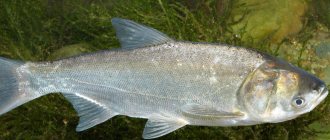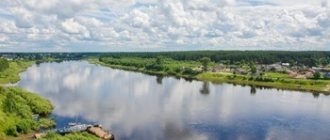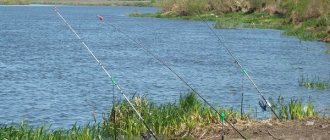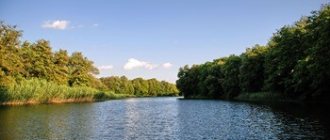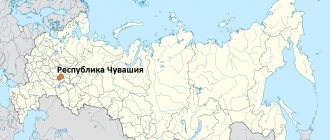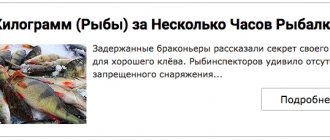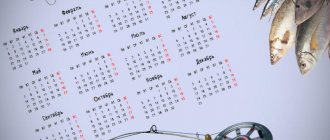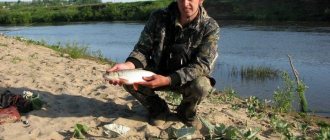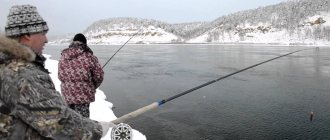The stormy temper of the Angara River was curbed and forced to work for people. During the construction of a hydroelectric station near the city of Bratsk, one of the largest reservoirs in the world was created. The size of the Bratsk Reservoir is impressive, and the richness and diversity of fish stocks attracts fishermen. Fishing in Bratsk will please not only amateurs, but also professionals.
Conditions for fishing in Bratsk
The width of the Bratsk Reservoir reaches 20 km, the average depth reaches 30 meters, the multi-kilometer coastline is distinguished by an abundance of various bays, both large and small, with different depths. On the shores in some places there are kilometer-long sandy beaches. The surface of the beaches is flat and smoothly goes into the depths. Conditions for fishing are very favorable. In summer you can fish from a boat or from the shore. Winter fishing is also very popular, but only four zones are designated for ice fishing. Fishing in winter in other places outside these zones is prohibited. The Irkutsk region invites everyone who is partial to fishing.
The fish world of the reservoir is diverse. Fish species common to European water bodies live here. But there are also those that are not found in the rivers of the Volga, Don and other European river basins. The Angara is a river in Bratsk, which is known for the abundance of fish of various sizes.
At the Bratsk Reservoir

We are once again going ice fishing. We leave for the Bratsk Reservoir. In the Kuitunsky district, where I live, the Oka River flows, which flows into the Angara. The reservoir is located along its bed. Podpor is located 50 kilometers from the district route
We chose an interesting place for fishing. We decided to settle down with fishing rods on the border of the Kuitun and Bratsk districts. This is 150 kilometers from our house. The distance is, of course, decent, there are places closer.
But its advantage is that the depth there reaches 30 meters! And we know well that when there is a sharp change in atmospheric pressure, fish are not caught in shallow water. And at a depth of 10 meters or more, the bite should be in all weather conditions.
There is another route to our fishing spot. It is 30 kilometers shorter, but the last 12 of them lie on the ice of the reservoir. But the road is not cleared. There are times when driving is simply impossible.
In general, the entire second half of the route to the place we have chosen passes through an area where there are no settlements. We call this land "taiga". Although, of course, it is wrong to use such a term. The road passes through an area where there are no longer large coniferous trees. There are only young growth in place of former clearings and islands of deciduous forest.
First perches
Our favorite fishing spot is the mouth of a small river that once flowed into the Oka. Now it is a bay 9 kilometers long. Here you can choose any depth for fishing.
We left the car on the shore and went our separate ways. I chose a place opposite our car, and my two companions went to the right. I drilled a hole 20 meters from the shore. The thickness of the ice turned out to be about 70 cm. The depth at this place reached five meters.
About two minutes later I pulled out a perch weighing 100 grams. At the reservoir in cold weather, stripers of approximately this size are caught. Larger specimens are rarely seen. The second perch took about 20 seconds after lowering the spoon. Then there was silence.
I drilled a hole about five meters away... there were no bites. Then I changed the bait and within a minute I caught a standard-sized perch. I attached the jig 50 centimeters above the spoon, but this did not affect the results. “Sailors” didn’t take any better. I pulled out 12 perches from 7 holes.
I went to find out how my comrades were doing. And by that time I was hungry - it was time to have a snack. It turned out that the friends caught about the same number: one had 10, the other had 14 specimens: a little more than drilled holes.
Installation of vents
After lunch we decided to move to another bay, which was half a kilometer around the bend. I had girders, and I intended to put them there. At first the bite in the new place was not encouraging. It was possible to pull out several perches from the drilled hole, and silence fell again.
Moving along the bay, after the next turn I saw a lone fisherman, who was about 400 meters away. Headed towards the stranger, storming the hole in a checkerboard pattern along the way. From one I caught about 30 perches! In the meantime, he continued to watch the fisherman. I noticed that he was cruising almost in place, moving only small distances.
When the sun touched the horizon, I remembered the girders that I had prepared for catching pikes . I placed the first one 50 meters from the shore, the second one at 30 meters, the third one at 10 meters. Being carried away by setting up the gear, I completely forgot about the other angler. Meanwhile, he came close to me.
We said hello and started talking. It turned out that the man came to the reservoir from the nearest settlement. The fisherman himself settled in a winter hut located on the shore.
A new acquaintance gave me advice: to place the zherlitsy, which the local population calls the word “udy,” no further than five meters from the shore. I didn’t want to move the already installed fishing gear: I didn’t have the energy or time. But I installed two more vents that were at my disposal exactly as recommended - three meters from the shore.
Effective bait
I asked the guy about his results. He replied that he caught about 300 perch from four holes!
- What kind of tackle and bait can you catch so much with? — I asked in surprise.
The fisherman explained that he uses a spoon made from an ordinary tablespoon, which was made of stainless steel. Seeing the doubt in my eyes, the man offered to go and see for himself. He pointed out that the fishing rod was still at the fishing spot.
I thought about it. The day was already drawing to a close and there was little daylight left. Yes, I still had to walk almost a kilometer to the car. However, curiosity still prevailed. We walked together to the place where my new acquaintance was fishing. There, four piles of perches could be seen in the snow.
The guy showed me the spinner. It was indeed made from a steel tablespoon with a yellow pattern. The length of the bait with a tee was about 10 centimeters.
— All the fish were caught with this lure?! — I asked a question and received an affirmative answer.
It amazed me. I tried different spoons and jigs, and my catch turned out to be almost 10 times smaller! Here the man used bait from an ordinary spoon the size of a small perch. And he achieved great results!
The Aboriginal Experience
Impressed by this meeting, I went to our car. He had a booth with a potbelly stove in it. So we could comfortably camp for the night without having to bother with tents. In the car I told my comrades about the bait with which the “aboriginal” caught fish. My companions were also very surprised.
In the morning I went to check the girders. I started with the one farthest from the shore... it turned out to be empty. The same fate befell the second and third. But the fourth and fifth girders, installed three meters from the shore, pleased me.
From one I took a caught pike weighing a couple of kilograms. On the other - another toothy robber who pulled about 1.5 kg. The local fisherman was right. The predator reacted only to the bait that was located near the shore.
I returned to my comrades, and we continued to catch perch. It was biting almost the same as the day before. In the afternoon it was time to pack up fishing rods and get ready to go home.
On the way, we discussed the completed fishing and decided that for the next trip it was necessary to take advantage of the experience of the “aboriginal” and make ourselves exactly the same lures as he had. Then we might have a better catch!
Valery Mineev , Irkutsk region
Features of catching valuable fish species
The fish (chir, or locally called shokur) is a relative of the whitefish, reaching a length of 50 to 85 cm. There are specimens weighing up to 11 kg, but usually fishermen catch fish weighing up to 4 kg. Shokur is caught with a spinning rod, a float rod or fly fishing. For bait, insects, their larvae, and shellfish meat are used. Shchokur likes to go to shallows where the depth is no more than 2 meters. The belly of the first fish caught is cut open and it is observed what it prefers to eat at the moment. This is how they select bait: whatever the fish has more in its stomach, that’s what it will greedily peck at. Whitefish move in schools, this is worth taking into account if you are interested in fishing in Bratsk.
After hooking, it puts up stubborn resistance, splashes heavily and can scare away the flock. You need to remove it from the water carefully, but quickly, and be sure to use a landing net. To quickly calm the fish, you can use a mallet. Caught fish must be gutted immediately, otherwise it will spoil very quickly.
Fishing for bream on the reservoir (video)
It is impossible to accurately calculate the moment of hooking, so you should hook at the first confident movement of the float or nod. The hook should be short and sharp.
As soon as the bream is hooked, it is slowly led to the hole. Particularly large specimens can break the tackle if they resist, so when jerking, it is necessary to gradually release the line, giving the hooked fish some freedom of movement. As soon as the fish on the hook gets tired and stops actively resisting, it is taken to the hole. The bream is removed from the hole using a hook or by hand, grasping it by the gill cover.
Fishing for grayling
Grayling is a close relative of salmon fish. Lives in cold water. It feels excellent in the Angara, is found in large quantities and is a desirable prey for local fishermen. They catch grayling using a spinning rod and a float rod. Earthworms, beetle larvae, and crustaceans are used as bait. Experienced fishermen often tint earthworms with organic dyes of red or pink.
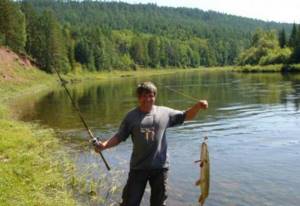
Grayling is very well caught using amphipods; local fishermen call it bormash. It is placed on the hook both live and slightly boiled. Surprisingly, grayling can be caught very well on artificial bait. Local fishermen make their own flies using a variety of materials, including even feathers from the necks of red roosters and other birds. The fly is immediately wound onto the hooks, without trying to achieve a real resemblance to a specific insect. Each species has its own fishing forecast in Bratsk.
Nearest populated areas:
| Bolsheokinskoye village | Bratsk city | Burninskaya Vikhorya (Burninsk) village near the station |
| Zyaba village near the station | Kaltuk village | Com dacha construction cooperative |
| Kuvatka village | Ozerny village near the station | Pervomaisky village near the station |
| Access village at the station |
Who is this cheesecake?
Peled is another fish of the whitefish family, for which the waters of the Angara have become native. Locals call it cheese. The fish weighs up to 3 kg and is up to 50 cm long. It is well caught with a float rod from the shore. Earthworms, bloodworms and shellfish meat are used as bait. It bites maggots reluctantly. It prefers to be at a distance of one to one and a half meters from the bottom, so the nozzle should be kept at this depth. Fruitful fishing in Bratsk is possible with the right approach.
The fish are very shy, so experienced fishermen cast bait as far from the shore as possible, and hide in the bushes. Some even wear camouflage suits. When fishing in winter, you have to shade the hole with snow and keep a distance from it. So winter, fishing, Bratsk are inseparable concepts!
A catch of 6 kilograms!
The predatory fish lenok delights sport fishing enthusiasts. It weighs up to 6 kg with a body length of 70 cm. It feeds on small fish, even swallowing mice and frogs. Likes to hunt in shallows. It is well caught with a spoon, but local fishermen prefer to use an artificial fish made of thin tinplate, they call it Devon. You can also catch lenok from the shore using earthworms and insect larvae. He readily grabs artificial and real flies.
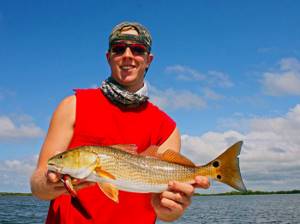
The Irkutsk region is rich in rivers and lakes. You will definitely find a place to relax with company.
Nearest water bodies:
| Dolonovka river | Ermakovka river | Dunaevka Bay narrow strait |
| Ermakovka Bay narrow strait | Zyaba Bay narrow strait | Sudovka Bay narrow strait |
| Black Narrow Strait Bay | Cape Danube protruding sea spit | Pier Porozhsky pier |
| Black River |
Common fish species in Bratsk
As for traditional fish species, local fishermen readily catch pike, perch, catfish, and carp. Bream, crucian carp, roach, and bleak are caught throughout the reservoir's waters from a boat and from the shore. Fishing from a boat is, of course, more convenient, but fishing from the shore has its advantages. You don’t have to sit in one place, but wander along the beautiful shores in search of intense biting spots. Visiting fishermen note that in the reservoir the perch, roach, bream, ide, carp, and grass carp are larger than in the reservoirs of the European part. Some even believe that the huge size of the water area stimulates the growth of fish. This is, of course, not entirely true. The rich food supply and clean ecology have created a favorable habitat for all types of fish. Predators fully perform the work of the reservoir's orderlies, and humans have not upset the balance of nature by predatory destruction of fish stocks.
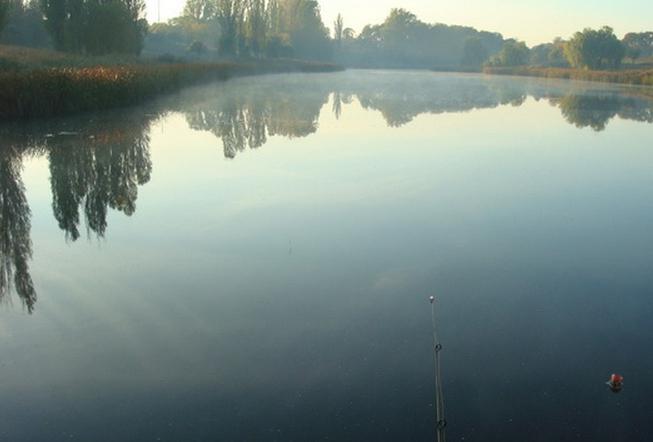
As a result, fishing in Bratsk can bring a lot of pleasure to everyone who wants to catch a wide variety of fish, including those that are considered delicacies.
Composition of water in the reservoir
If in the upper part of the reservoir, where the Angara with its clean Baikal water flows into it, the ecosystem is healthy, the water has a high second class in purity, then in the area of the source from the reservoir, at the dam, it shows extreme levels of pollution. The composition of the water has a low degree of mineral dissolution - this is a typical picture for the hydrocarbonate type of water resources of the Earth.
Before the construction of a dam on it, the Angara was very rich in commercial fish species. Living conditions for sturgeon and salmon were ideal in terms of temperature, abundance of food, and flow speed. Today, the reservoir has a typical lake composition of inhabitants. These are mainly non-commercial fish species: perch, pike, bream, ruff.
